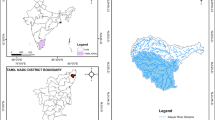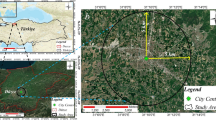Abstract
As one of the most vulnerable coasts in the continental USA, the Lower Mississippi River Basin (LMRB) region has endured numerous hazards over the past decades. The sustainability of this region has drawn great attention from the international, national, and local communities, wanting to understand how the region as a system develops under intense interplay between the natural and human factors. A major problem in this deltaic region is significant land loss over the years due to a combination of natural and human factors. The main scientific and management questions are what factors contribute to the land use land cover (LULC) changes in this region, can we model the changes, and how would the LULC look like in the future given the current factors? This study analyzed the LULC changes of the region between 1996 and 2006 by utilizing an artificial neural network (ANN) to derive the LULC change rules from 15 human and natural variables. The rules were then used to simulate future scenarios in a cellular automation model. A stochastic element was added in the model to represent factors that were not included in the current model. The analysis was conducted for two sub-regions in the study area for comparison. The results show that the derived ANN models could simulate the LULC changes with a high degree of accuracy (above 92 % on average). A total loss of 263 km2 in wetlands from 2006 to 2016 was projected, whereas the trend of forest loss will cease. These scenarios provide useful information to decision makers for better planning and management of the region.









Similar content being viewed by others
References
Anderson, J.R., Hardy, E.E., Roach, J.T. & Witmer, R.E. (1976). A land use and land cover classification system for use with remote sensor data. Washington: United States Government Printing Office.
Badoe, D. A., & Miller, E. J. (2000). Transportation–land-use interaction: empirical findings in North America, and their implications for modeling. Transportation Research Part D: Transport and Environment, 5(4), 235–263.
Basheer, I. A., & Hajmeer, M. (2000). Artificial neural networks: fundamentals, computing, design, and application. Journal of Microbiological Methods, 43(1), 3–31.
Batty, M. (2007). Cities and complexity: understanding cities with cellular automata, agent-based models, and fractals. Cambridge: The MIT press.
Batty, M., Xie, Y., & Sun, Z. (1999). Modeling urban dynamics through GIS-based cellular automata. Computers, Environment and Urban Systems, 23(3), 205–233.
Berger, T. (2001). Agent-based spatial models applied to agriculture: a simulation tool for technology diffusion, resource use changes and policy analysis. Agricultural Economics, 25(2–3), 245–260.
Brown, D.G., Goovaerts, P., Burnicki, A., & Li, M.Y. (2002). Stochastic simulation of land-cover change using geostatistics and generalized additive models. Photogrammetric Engineering and Remote Sensing, 68(10), 1051–1061.
Burkett, V. R., Zilkoski, D. B., & Hart, D. A. (2002). Sea-level rise and subsidence: implications for flooding in New Orleans, Louisiana. In US Geological Survey Subsidence Interest Group Conference: Proceedings of the Technical Meeting, Galveston, Texas, 27-29 November 2001.
Clarke, K. C., & Gaydos, L. J. (1998). Loose-coupling a cellular automaton model and GIS: long-term urban growth prediction for San Francisco and Washington/Baltimore. International Journal of Geographical Information Science, 12(7), 699–714.
Clarke, K.C., Dietzel, C., & Goldstein, N.C. (2007). A decade of SLEUTHing: lessons learned from applications of a cellular automaton land use change model. Classics in IJGIS: twenty years of the international journal of geographical information science and systems, 413-427.
Coastal Protection and Restoration Authority of Louisiana (CPRA) (2012). Louisiana’s coastal master plan for a sustainable coast. State of Louisiana, Baton Rouge, p. 189.
Crooks, A., Castle, C., & Batty, M. (2008). Key challenges in agent-based modelling for geo-spatial simulation. Computers, Environment and Urban Systems, 32(6), 417–430.
Day, J. W., Boesch, D. F., Clairain, E. J., Kemp, G. P., Laska, S. B., Mitsch, W. J., et al. (2007). Restoration of the Mississippi delta: lessons from hurricanes Katrina and Rita. Science, 315(5819), 1679–1684.
Dewan, A. M., & Yamaguchi, Y. (2009). Using remote sensing and GIS to detect and monitor land use and land cover change in Dhaka Metropolitan of Bangladesh during 1960-2005. Environmental Monitoring and Assessment, 150(1–4), 237–249.
Dobson, J.E., Ferguson, R.L., Field, D.W., Wood, L.L., Haddad, K.D., Iredale, I.H., et al. (1995). NOAA Coastal Change Analysis Program (C-CAP): guidance for regional implementation. US Department of Commerce, National Oceanic and Atmospheric Administration, National Marine Fisheries Service.
Feng, Y., & Liu, Y. (2012). A heuristic cellular automata approach for modelling urban land-use change based on simulated annealing. International Journal of Geographical Information Science, 27(3), 449–466.
Foody, G. M. (1996). Relating the land-cover composition of mixed pixels to artificial neural network classification output. Photogrammetric Engineering and Remote Sensing, 62(5), 491–498.
García, A. M., Santé, I., Boullón, M. & Crecente, R. (2013). Calibration of an urban cellular automaton model by using statistical techniques and a genetic algorithm. Application to a small urban settlement of NW Spain. International Journal of Geographical Information Science, 1-19.
Gong, P. (1996). Integrated analysis of spatial data from multiple sources: using evidential reasoning and artificial neural network techniques for geological mapping. American Society for Photogrammetry and Remote Sensing, 62(5).
González, J. L., & Tornqvist, T. E. (2006). Coastal Louisiana in crisis: subsidence or sea level rise? Eos. Transactions American Geophysical Union, 87(45), 493–498.
Jain, A. K., Jianchang, M., & Mohiuddin, K. M. (1996). Artificial neural networks: a tutorial. Computer, 29(3), 31–44.
Ju, W., & Lam, N. (2007). Urban land use classification: applying texture analysis and artificial intelligence. Imaging Notes, 22(3), 26–30.
Lam, N.S.N., Arenas, H., Li, Z., Liu, K.B. (2009a). An estimate of population impacted by climate change along the U.S. Coast. Journal of Coastal Research, 1522-1526.
Lam, N.S.N., Arenas, H., Pace, K., LeSage, J., & Campanella, R. (2012). Predictors of business return in New Orleans after Hurricane Katrina. PloS One, 7(10), e47935.
Lam, N.S.N., Pace, K., Campanella, R., LeSage, J., & Arenas, H. (2009b). Business return in New Orleans: decision making amid post-Katrina uncertainty. PloS One, 4(8), e6765.
Lambin, E. F., Geist, H. J., & Lepers, E. (2003). Dynamics of land-use and land-cover change in tropical regions. Annual Review of Environment and Resources, 28(1), 205–241.
Lauf, S., Haase, D., Hostert, P., Lakes, T., & Kleinschmit, B. (2012). Uncovering land-use dynamics driven by human decision-making—a combined model approach using cellular automata and system dynamics. Environmental Modelling & Software, 27–28, 71–82.
Leemans, R., & Eickhout, B. (2004). Another reason for concern: regional and global impacts on ecosystems for different levels of climate change. Global Environmental Change, 14(3), 219–228.
Li, X., & Yeh, A. G.-O. (2002). Neural-network-based cellular automata for simulating multiple land use changes using GIS. International Journal of Geographical Information Science, 16(4), 323–343.
Li, X., & Yeh, A. G.-O. (2004). Data mining of cellular automata's transition rules. International Journal of Geographical Information Science, 18(8), 723–744.
Liu, J., Dietz, T., Carpenter, S.R., Folke, C., Alberti, M., Redman, C.L., et al. (2007). Coupled human and natural systems. AMBIO: A Journal of the Human Environment, 36(8), 639–649.
Liu, X., Li, X., Shi, X., Huang, K., & Liu, Y. (2012). A multi-type ant colony optimization (MACO) method for optimal land use allocation in large areas. International Journal of Geographical Information Science, 26(7), 1325–1343.
Liu, X., Li, X., Shi, X., Zhang, X., & Chen, Y. (2010). Simulating land-use dynamics under planning policies by integrating artificial immune systems with cellular automata. International Journal of Geographical Information Science, 24(5), 783–802.
Lo, C. P., & Yang, X. (2002). Drivers of land-use/land-cover changes and dynamic modeling for the Atlanta, Georgia metropolitan area. Photogrammetric Engineering and Remote Sensing, 68(10), 1073–1082.
Mahajan, Y., & Venkatachalam, P. (2009). Neural network based cellular automata model for dynamic spatial modeling in GIS. In O. Gervasi et al. (Eds.), Computational science and its applications—ICCSA 2009 (pp. 341–352). Heidelberg: Springer Berlin.
Murray-Rust, D., Rieser, V., Robinson, D.T., Milicic, V., & Rounsevell, M. (2013). Agent-based modelling of land use dynamics and residential quality of life for future scenarios. Environmental Modelling & Software, 46, 75–89.
Okwuashi, O., Isong, M., Eyo, E., Eyoh, A., Nwanekezie, O., & Olayinka, D.N., et al. (2012). GIS Cellular automata using artificial neural network for land use change simulation of Lagos, Nigeria. Journal of Geography and Geology, 4(2).
Overmars, K. P., De Koning, G. H. J., & Veldkamp, A. (2003). Spatial autocorrelation in multi-scale land use models. Ecological Modelling, 164(2–3), 257–270.
Parker, D.C., Manson, S.M., Janssen, M.A., Hoffmann, M.J., & Deadman, P. (2003). Multi-agent systems for the simulation of land-use and land-cover change: a review. Annals of the Association of American Geographers, 93(2), 314–337.
Perez-Vega, A., Mas, J. F., & Ligmann-Zielinska, A. (2012). Comparing two approaches to land use/cover change modeling and their implications for the assessment of biodiversity loss in a deciduous tropical forest. Environmental Modelling & Software, 29(1), 11–23.
Reyes, E., White, M. L., Martin, J. F., Kemp, G. P., Day, J. W., & Aravamuthan, V. (2000). Landscape modeling of coastal habitat change in the Mississippi delta. Ecology, 81(8), 2331–2349.
Schweitzer, C., Priess, J. A., & Das, S. (2011). A generic framework for land-use modelling. Environmental Modelling & Software, 26(8), 1052–1055.
Stewart, T. J., Janssen, R., & Van Herwijnen, M. (2004). A genetic algorithm approach to multiobjective land use planning. Computers & Operations Research, 31(14), 2293–2313.
Stokstad, E. (2005). Louisiana’s wetlands struggle for survival: new focus. Science, 310(5752), 1264–1266.
Turner, B. L. (2010). Vulnerability and resilience: coalescing or paralleling approaches for sustainability science? Global Environmental Change, 20(4), 570–576.
Vicari, A., Alexis, H., Del Negro, C., Coltelli, M., Marsella, M., & Proietti, C. (2007). Modeling of the 2001 lava flow at Etna volcano by a cellular automata approach. Environmental Modelling & Software, 22(10), 1465–1471.
Wang, F. (2007). Land-cover and land-use study using genetic algorithms, petri nets, and cellular automata. (Ph.D. dissertation). Louisiana State University.
Wang, Z.M., Zhang, B., Zhang, S.Q., Li, X.Y., Liu, D.W., & Song, K.S., et al. (2006). Changes of land use and of ecosystem service values in Sanjiang Plain, northeast China. Environmental Monitoring and Assessment, 112(1–3), 69–91.
Ward, D. P., Murray, A. T., & Phinn, S. R. (2000). A stochastically constrained cellular model of urban growth. Computers, Environment and Urban Systems, 24(6), 539–558.
Wear, D. N., & Bolstad, P. (1998). Land-use changes in southern Appalachian landscapes: spatial analysis and forecast evaluation. Ecosystems, 1(6), 575–594.
Wu, F., & Webster, C. J. (1998). Simulation of land development through the integration of cellular automata and multicriteria evaluation. Environment and Planning B: Planning and Design, 25(1), 103–126.
Zhou, G. (2006). Detecting the social-economic conditions of urban neighborhoods through a combined methodology of wavelet transform and artificial neural networks. (Ph.D. dissertation). Louisiana State University.
Zhou, J., & Civco, D. L. (1996). Using genetic learning neural networks for spatial decision making in GIS. Bethesda: ETATS-UNIS: American Society for Photogrammetry and Remote Sensing.
Acknowledgments
This material is based upon work supported by a research grant from the US National Science Foundation under the Dynamics of Coupled Natural Human Systems (CNH) Program (grant number: 1212112). Any opinions, findings, conclusions, and recommendations expressed in this material are those of the authors and do not necessarily reflect the views of the funding agency.
Author information
Authors and Affiliations
Corresponding author
Rights and permissions
About this article
Cite this article
Qiang, Y., Lam, N.S.N. Modeling land use and land cover changes in a vulnerable coastal region using artificial neural networks and cellular automata. Environ Monit Assess 187, 57 (2015). https://doi.org/10.1007/s10661-015-4298-8
Received:
Accepted:
Published:
DOI: https://doi.org/10.1007/s10661-015-4298-8




